The HTC One (M8) Review
by Anand Lal Shimpi & Joshua Ho on March 26, 2014 7:00 PM EST- Posted in
- Smartphones
- HTC
- Mobile
- HTC One
Battery Life
The new One features an integrated 3.8V 2600mAh battery (9.88 Wh), a 13% increase in capacity compared to the previous model. The battery comparison isn’t that simple however. The M8 has a larger display (5” vs 4.7”) but it also has a higher performing and more power efficient SoC (Snapdragon 801 vs. 600). To find out how the new One stacks up against its predecessor, we turn to a mix of old and new battery life tests to help better characterize the device.
We’ll start with our standard browser based battery life tests. Keep in mind here these tests are as much about replicating a particular CPU profile as they are about loading specific web pages in order.
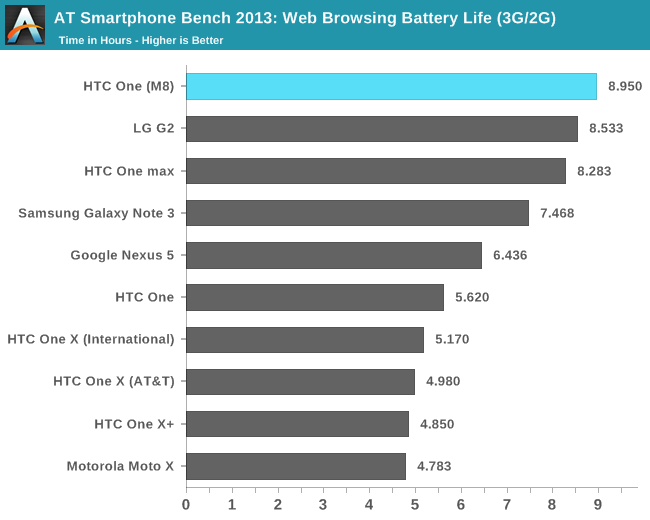
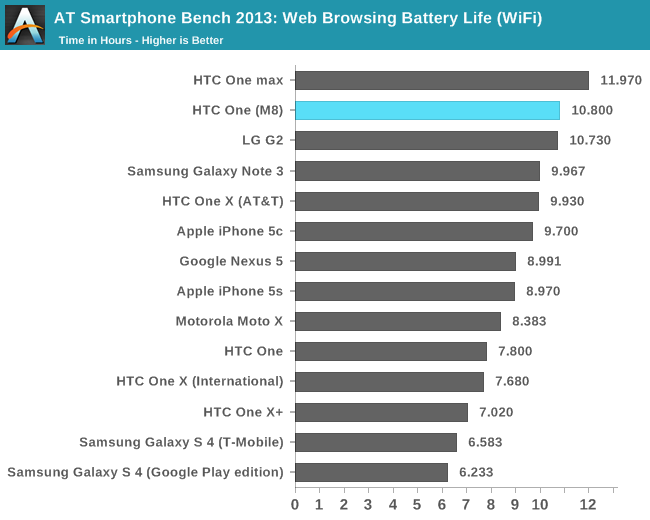
We saw a substantial gain in battery life with Snapdragon 800, and 801 extends that even further. For the same, relatively light (yet constant) workload, the M8 improves battery life over the M7 by as much as 71%. On WiFi the advantage drops to only 38%, but we’re still talking about absolutely huge generational gains.
A constant workload is only one part of the story though. More often than not, when you’re faced with faster compute you end up doing more. To see what the other extreme of battery life looks like I turned to two canned tests: BaseMark OS II and GFXBench 3.0.
I ran both of these tests under the same controlled conditions we always use, with all displays calibrated to 200 nits. BaseMark OS II runs through a bunch of CPU and storage benchmarks (basically the same tests used for the BaseMark OS II system and memory tests), as fast as possible, until the battery dies.
I like this benchmark as it gives us an indication of worst case battery life if you’re absolutely hammering the CPU (and storage) relentlessly.
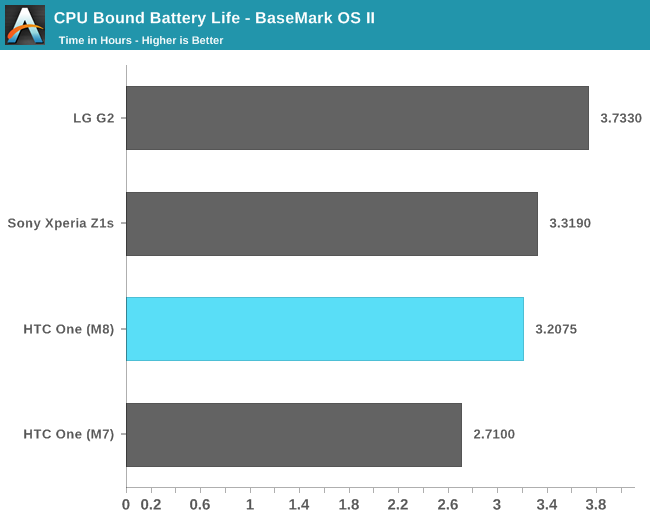
Despite the faster CPU cores, the M8’s battery life actually goes up compared to M7. Here we’re really seeing the benefits of 801’s updated 28nm HPm process compared to the Snapdragon 600’s 28nm LP process.
GFXBench provides a similar test, with effectively uncapped performance (on today’s devices at least since we’re not hitting v-sync limits), but stressing the GPU instead of the CPU. Here we’re running the T-Rex HD benchmark, onscreen, until the battery dies.

This is the first and only test we’ve got here that shows a regression in battery life compared to M7. The M8 loses about 6% of runtime compared to the M7, despite having a larger battery. Now look at what happens if we look at performance at the end of the run:
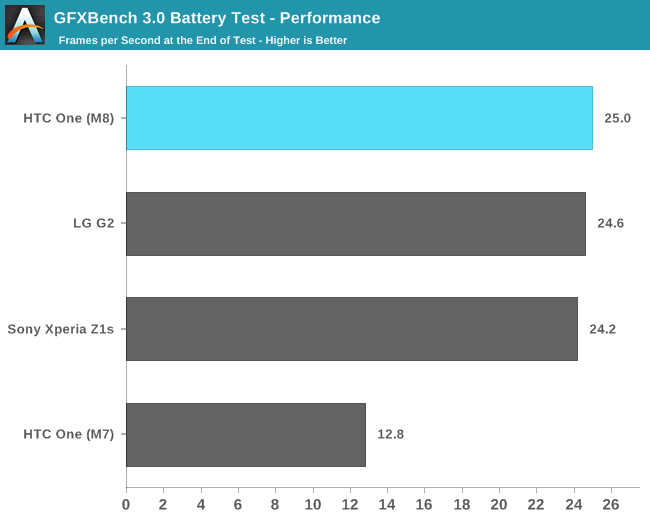
Now the M8’s battery life regression doesn’t look so bad. You give up 6% of runtime but you get almost twice the performance compared to M7. Snapdragon 801 is just a huge upgrade compared to 600.
Charge Time
The M8 features a Qualcomm Quick Charge 2.0 enabled PMIC, which enables faster battery charge times through higher voltage charging. Unfortunately the in-box wall adapter is only Quick Charge 1.5 compliant so you'll only pull 7.5W from the wall. HTC expects to offer a Quick Charge 2.0 compliant power adapter later this year.
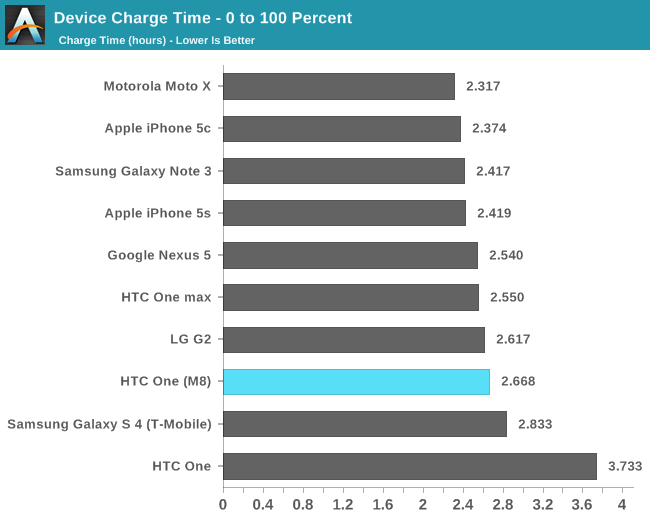
The M8's charge time is a bit slow compared to what we've seen from other devices with larger batteries.










222 Comments
View All Comments
secretmanofagent - Wednesday, March 26, 2014 - link
Does the new Sense UI allow you to see emails on the lock screen? They took that away from the One Mini in the 4.3 update. They also moved the widgets to a painful swipe to the left, was hoping they fixed that too.gg555 - Wednesday, March 26, 2014 - link
No review of the noise cancellation? Sigh. I've come to count on AnandTech as the only site that takes this seriously. But it seems to be getting passed over in recent reviews.hangfirew8 - Saturday, March 29, 2014 - link
Love Love Love the noise cancellation on my M7. Thank you for reminding me of that.Yes we need to keep on top of that.
varad - Wednesday, March 26, 2014 - link
Neat review but seriously, where is Brian Klug?yelped - Wednesday, March 26, 2014 - link
Great question! Seriously, this review wouldn't have been missing an analysis on the audio quality, and the network connectivity (WiFi, Bluetooth..). Also, can you explain what the Sprint version is using instead of the QFE1000?Thanks!
jasonelmore - Wednesday, March 26, 2014 - link
something is definitely up. Anand staff have been dodging questions about the whereabouts of Brian Klug for several days, so me thinks Anand and Brian had some kind of "falling out". Whether it was over Pay, or internal beef, it definitely makes you wonder. For example, he did not attend Nvidia's conference, nor was he part of a Major Android flagship review.Blairh - Thursday, March 27, 2014 - link
Anand admitted in private to Brian that he loves SD cards in phones and that was that.yelped - Thursday, March 27, 2014 - link
Lol. Though I am wondering what's going on.. Also, any word why Sprint has different front ends and why?asaini007 - Thursday, March 27, 2014 - link
HahaAnand Lal Shimpi - Thursday, March 27, 2014 - link
There's no falling out, I just had dinner with Brian :) Can't talk about much more for now, sorry :)Take care,
Anand